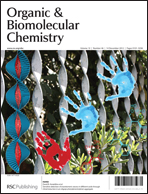Exploring the effect of aminoglycoside guanidinylation on ligands for Tau exon 10 splicing regulatory element RNA†
Abstract
We describe the effect of guanidinylation of the aminoglycoside moiety on acridine–neamine-containing ligands for the stem–loop structure located at the exon 10–5′-intron junction of Tau pre-mRNA, an important regulatory element of tau gene alternative splicing. On the basis of dynamic combinatorial chemistry experiments, ligands that combine guanidinoneamine and two different acridines were synthesized and their RNA-binding properties were compared with those of their amino precursors. Fluorescence titration experiments and UV-monitored melting curves revealed that guanidinylation has a positive effect both on the binding affinity and specificity of the ligands for the stem–loop RNA, as well as on the stabilization of all RNA sequences evaluated, particularly some mutated sequences associated with the development of FTDP-17 tauopathy. However, this correlation between binding affinity and stabilization due to guanidinylation was only found in ligands containing a longer spacer between the acridine and guanidinoneamine moieties, since a shorter spacer produced the opposite effect (e.g. lower binding affinity and lower stabilization). Furthermore, spectroscopic studies suggest that ligand binding does not significantly change the overall RNA structure upon binding (circular dichroism) and that the acridine moiety might intercalate near the bulged region of the stem–loop structure (UV-Vis and NMR spectroscopy).


 Please wait while we load your content...
Please wait while we load your content...